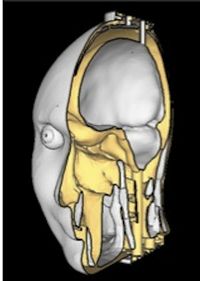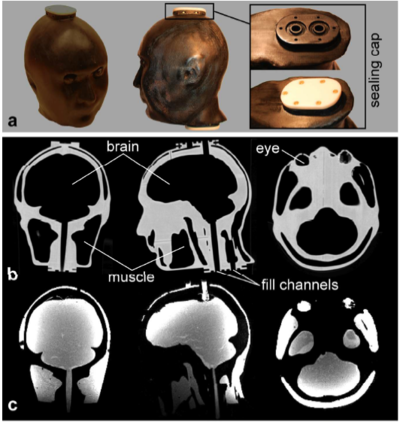Difference between revisions of "MGH head 1:MGH head 1"
Jump to navigation
Jump to search
| (14 intermediate revisions by 3 users not shown) | |||
| Line 1: | Line 1: | ||
| + | [[File:giorgio_phant.jpg|200px|thumb|right|]] | ||
| + | === Citation === | ||
| + | Nadine N. Graedel, Jonathan R. Polimeni, Bastien Guerin, Borjan Gagoski and Lawrence L. Wald (2015). "An anatomically realistic temperature phantom for radiofrequency heating measurements". Magnetic Resonance in Medicine 73(1):442–450 | ||
| − | == | + | === Download files === |
| − | [ | + | Click [https://phantoms.martinos.org/images/3/36/MGH_head_1.zip here] to download the CAD model. |
| − | |||
| − | |||
| − | |||
| − | + | === Phantom description === | |
| + | This phantom is based on a 1mm isotropic segmented head model which was labeled as described in [http://www.ncbi.nlm.nih.gov/pubmed/18985401 Makris et al]. | ||
| − | + | The segmented head data was converted into a simplified surface model with two compartments: Brain and other soft tissues. Bone and air (both low epsilon, low conductivity) are printed together out of plastic material with similar electrical properties. | |
| − | + | === Special considerations === | |
| + | The sealing flange uses an o-ring. | ||
| − | + | [[File:Phantom_figure_CT_MR.png|400px|thumb|right|]] | |
Latest revision as of 14:44, 24 March 2015
Citation
Nadine N. Graedel, Jonathan R. Polimeni, Bastien Guerin, Borjan Gagoski and Lawrence L. Wald (2015). "An anatomically realistic temperature phantom for radiofrequency heating measurements". Magnetic Resonance in Medicine 73(1):442–450
Download files
Click here to download the CAD model.
Phantom description
This phantom is based on a 1mm isotropic segmented head model which was labeled as described in Makris et al.
The segmented head data was converted into a simplified surface model with two compartments: Brain and other soft tissues. Bone and air (both low epsilon, low conductivity) are printed together out of plastic material with similar electrical properties.
Special considerations
The sealing flange uses an o-ring.

